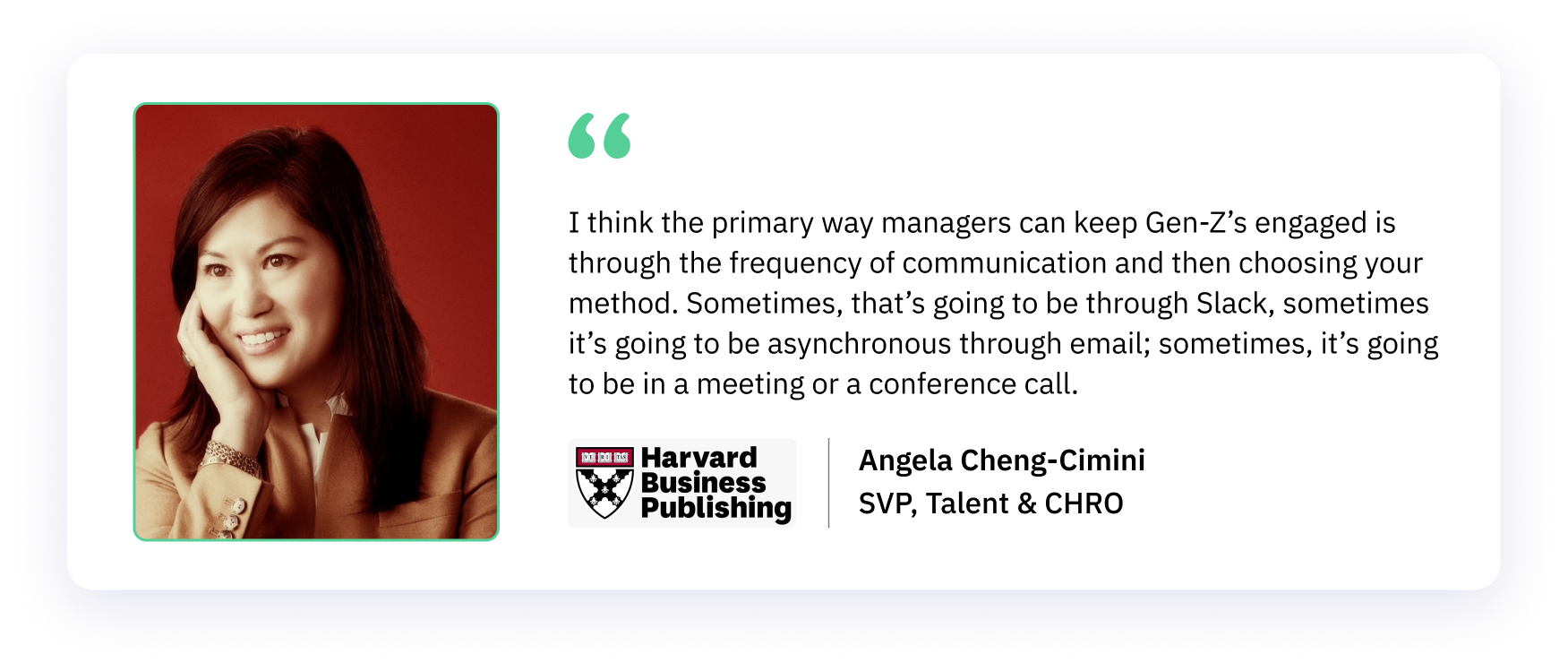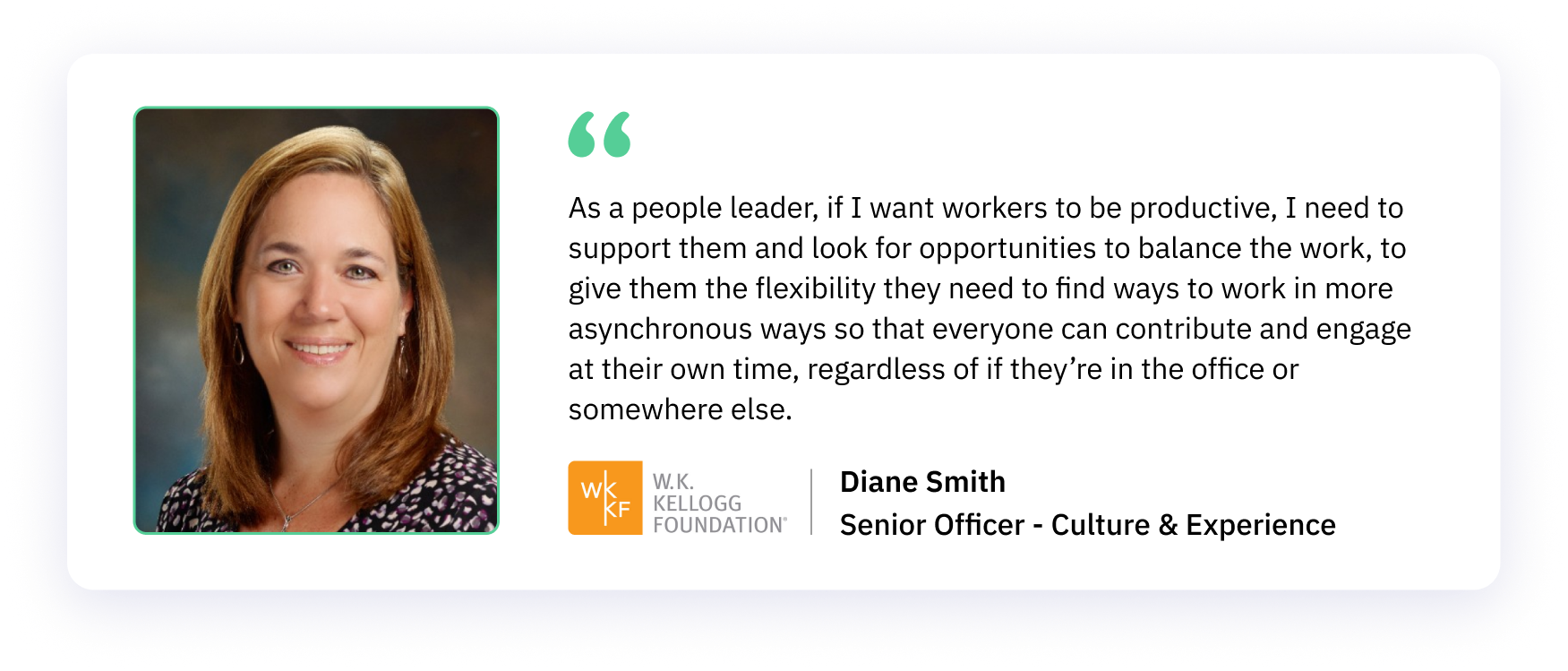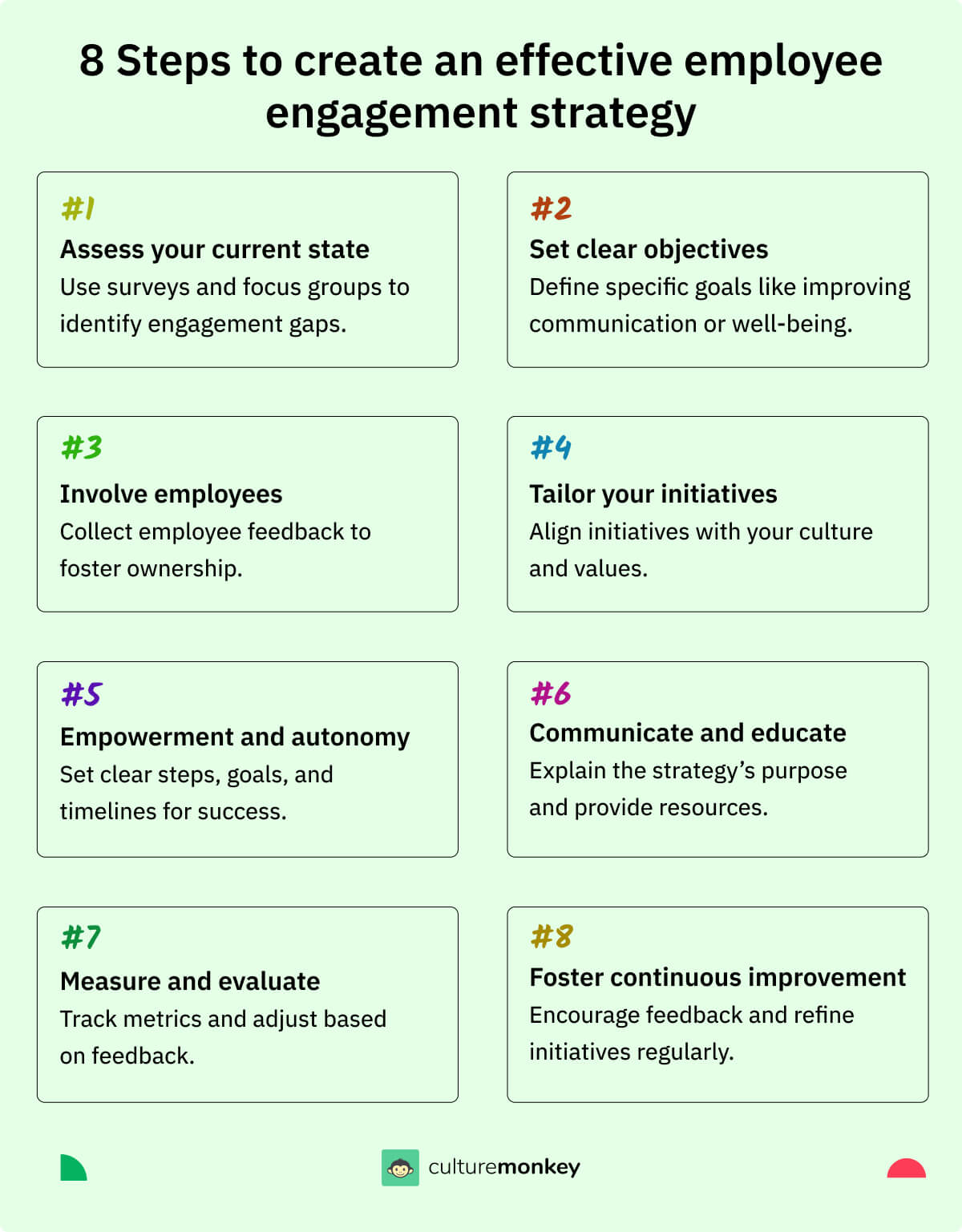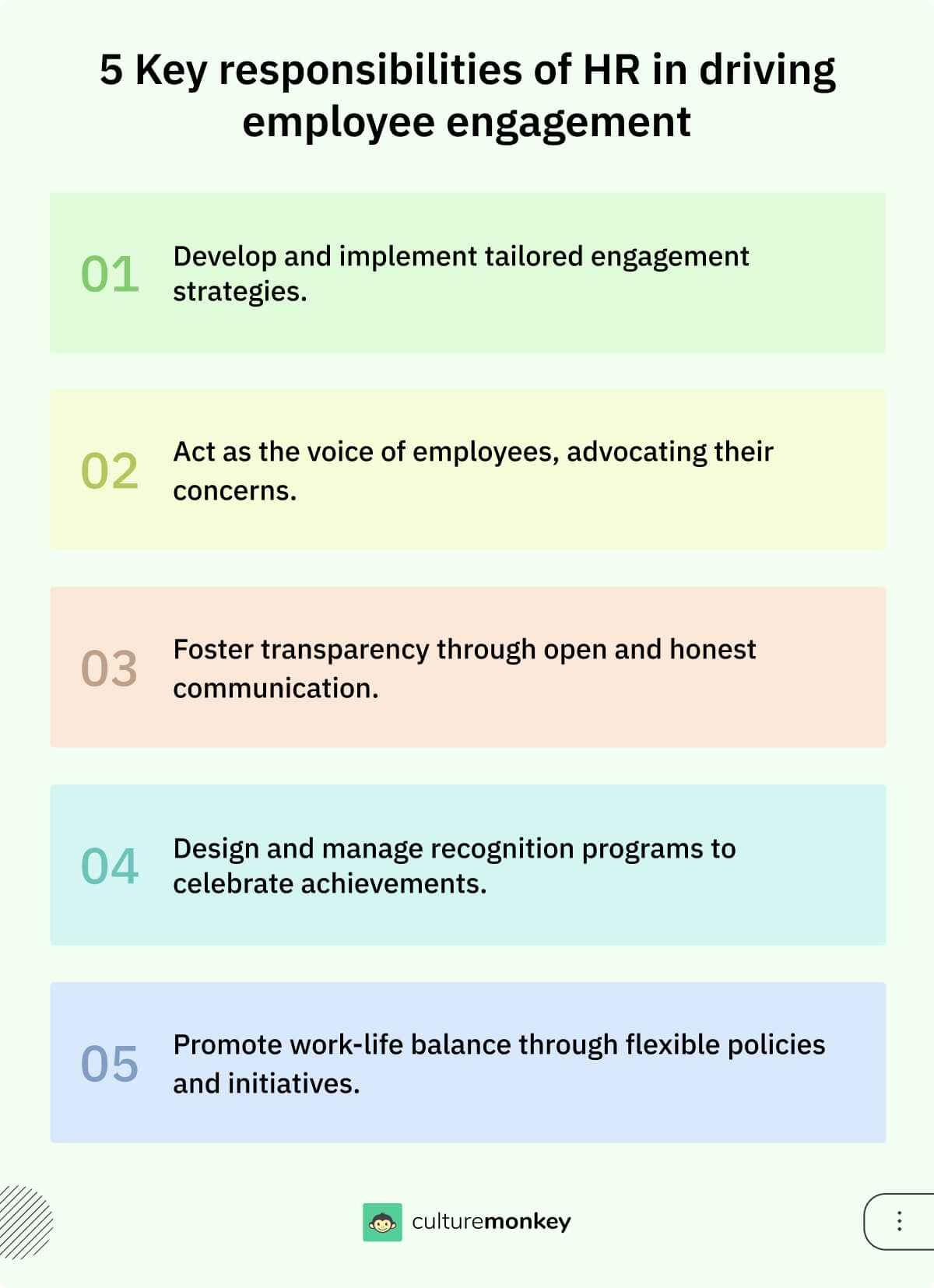Top 20 employee engagement initiatives to maximize workplace engagement

Remember those amusement park days with friends? You’d arrive buzzing with excitement, only for chaos to set in. One friend bolts to the roller coaster, another queues for funnel cake, and someone’s already lost in the arcade.
Half the group insists on a game plan, while the rest just want to wander and see where the day takes them.
By midday, you're in splintered groups, patience is thinning, and the day’s magic feels off. But occasionally, you’d all sit down, swap ideas, agree on the must-do rides and food stops, and something clicked.
Everyone felt heard, the group stayed together (mostly), and the day became one to remember.
That’s exactly what employee engagement initiatives aim to do—create shared direction, collective satisfaction, and a sense that everyone’s voice mattered.
Whether you’re someone who shapes culture, builds teams, or steers strategy, this blog offers fresh ideas and grounded guidance to help you design engagement efforts that actually stick.
Maya Angelou once said, "People will forget what you said, people will forget what you did, but people will never forget how you made them feel."
Blog Highlights


What do employee engagement initiatives mean?

Employee engagement initiatives refer to the various strategies, programs, and actions implemented by organizations to create a positive and fulfilling work environment where employees are motivated, committed, and actively involved in their roles. These initiatives are designed to enhance job satisfaction, foster a sense of belonging, and promote a culture of continuous improvement in the workplace.
Employee engagement initiatives can take many forms, ranging from small gestures to comprehensive employee engagement programs. They can include activities such as team-building exercises, wellness programs, flexible work arrangements, skill development opportunities, mentoring programs, recognition and rewards systems, and open communication channels.
The essence of employee engagement initiatives lies in nurturing a supportive culture that values and invests in its employees. When employees feel engaged, they are more likely to contribute their best efforts, collaborate with their colleagues, and take ownership of their work. Engaged employees are also more resilient, innovative, and committed to the organization's success.
In short, employee engagement initiatives are the driving force behind creating a thriving workplace where employees feel motivated, connected, and inspired to give their best, leading to improved performance, increased productivity, and a positive organizational culture.
What are employee engagement programs?

Employee engagement programs are strategic initiatives formulated by companies to foster a sense of commitment, enthusiasm, and dedication among their employees towards their roles and the organization as a whole. At the core of these programs is the recognition that engaged employees are not merely motivated by monetary incentives, but driven by a connection to their work and belief in the mission.
These programs encompass a wide array of activities and strategies designed to create a conducive work environment where employees feel valued, empowered, and emotionally invested.
One facet of such programs involves open channels of communication that allow employees to voice their opinions, concerns, and suggestions. This not only makes them feel heard but also contributes to a more transparent and inclusive work culture.
Skill development workshops, training sessions, and career growth opportunities are another vital component. These offerings not only enhance employees' skills but also signify the organization's investment in their professional journey.
Moreover, employee engagement programs often include wellness initiatives that prioritize employees' physical and mental well-being. Such programs showcase an organization's commitment to holistic employee welfare.
What is employee engagement program in HR?

An employee engagement program within HR is a strategic approach designed to cultivate a profound connection between employees and their work and enhance their commitment to the organization's goals. At its essence, such a program functions as a comprehensive framework encompassing a range of initiatives, policies, and activities to create a positive and empowering work environment.
Through open communication channels, skill development opportunities, recognition and rewards systems, wellness initiatives, and avenues for career growth, these programs work cohesively to not only heighten job satisfaction but also amplify overall organizational performance.
By addressing employees' intrinsic motivations and needs, an employee engagement program contributes to increased productivity, reduced turnover rates, and heightened loyalty among staff members.
In essence, it serves as a compass guiding the HR efforts towards creating an atmosphere where employees feel valued, supported, and compelled to invest their best efforts into the success of the organization.
5 Employee engagement statistics that you should know!

- According to Gallup, 85% of employees are either not engaged or actively disengaged. Within this group, 67% are unengaged, displaying indifference towards their company's success and fulfilling only minimal requirements.
- Forbes reports that a disengaged employee at the average salary level can result in an annual cost of nearly $16,000.
- Companies with the highest employee engagement rates, as highlighted by Gallup, experience a 21% increase in profitability.
- Research from Workest reveals that among over 600 US businesses with 50-500 employees, 63.3% of companies find retaining employees more challenging than recruiting them.
- A survey covered by Insider discloses that 73% of 2,099 respondents considering their employment plans are contemplating quitting. Of these individuals, over 25% express comfort with leaving their current job without securing a new position beforehand.
How do you create an employee engagement program?

Have you ever been part of a workplace where you felt genuinely excited to come in every day, where your ideas were valued, and your growth was nurtured? That's the magic of a well-crafted employee engagement program. Let's dive into how you can create one to cultivate a thriving and motivated workforce:
- Assessment and understanding: Begin by asking yourself, "What do my employees need and want?" Conduct surveys, interviews, and feedback sessions to gauge their preferences and pain points. Understanding their aspirations helps tailor the program to resonate with their needs.
- Clear goals and objectives: Define the purpose of your program. Whether it's boosting collaboration, enhancing skill sets, or improving work-life balance, having clear goals guides your efforts.
- Leadership buy-in: A successful program needs endorsement from the top. Gain support and active participation from leadership to demonstrate the program's significance.
- Tailored communication: Develop a communication strategy that keeps employees informed about program updates, benefits, and achievements. Regularly share success stories to inspire others.

- Recognition and rewards: Implement a recognition system that appreciates employees' efforts. This could range from a simple 'thank you' note to monthly awards celebrating outstanding contributions.
- Professional growth opportunities: Offer training sessions, workshops, and mentorship programs to foster employee engagement and their professional and personal development. When they see a path for growth, they're more likely to stay engaged.
- Wellness initiatives: A healthy employee is a happy employee. Incorporate wellness activities like yoga sessions, health challenges, or mental health resources to show you care about their holistic well-being.
- Flexible work environment: In today's world, flexibility is key. Allow for remote work options or flexible hours to accommodate different lifestyles and promote employee engagement and work-life balance.
- Social engagement: Arrange team-building activities, social events, and community service projects. These help employees connect beyond work tasks, strengthening their bond with the organization.
- Feedback loop: Create a system for continuous feedback. This not only gives employees a voice but also helps you fine-tune the program based on their evolving needs.
- Measure and adjust: Regularly assess the program's impact. Are employees more motivated? Is retention improving? Use data to refine the program as you go along.
- Celebrate milestones: Recognize program milestones and achievements. This showcases the program's effectiveness and maintains excitement.
- Evolutionary approach: Stay adaptable. As your workforce evolves, so should your program. Stay attuned to changes and adjust your employee engagement strategies accordingly.
- Peer mentoring: Encourage peer mentoring programs where employees can share knowledge and skills with one another. This fosters a sense of community, boosts confidence, and helps employees learn and grow from each other's experiences, strengthening overall engagement.
- Diversity and inclusion: Prioritize creating an inclusive environment where diverse voices are heard and valued. By promoting diversity and ensuring that everyone feels a sense of belonging, you can significantly enhance employee engagement and satisfaction.
Types of employee engagement programs

Let's explore the types that can turn your workplace into that home away from home:Wellness wonderland
Have you ever wished for an oasis of calm amidst the hustle? Wellness-focused programs are here to grant that wish. From yoga sessions and meditation workshops to health challenges and fitness classes, these programs promote both physical and mental well-being.
Learning galore
In a world that's ever-evolving, learning is a superpower. Learning-oriented programs offer workshops, training sessions, and opportunities for employees to upskill. They not only enhance professional growth but also keep employees engaged by nurturing their curiosity.
Team bonding adventures
Remember the thrill of a school field trip? Team bonding programs bring that excitement to the workplace. Think of team-building exercises, outdoor activities, and even escape room challenges. These activities strengthen relationships, boost employee engagement, collaboration, and inject a sense of camaraderie.
Innovation incubators
Who doesn't love the chance to let their creativity soar? Innovation programs encourage employees to share ideas, propose solutions, and participate in brainstorming sessions. This not only makes them feel valued but can also lead to groundbreaking insights for the company.
Recognition and rewards galas
Everyone loves a pat on the back. Recognition and rewards programs celebrate outstanding contributions. This could range from Employee of the Month awards to creative 'kudos' systems where colleagues can appreciate each other's efforts.
Flexible work arrangements
Balancing work and life can sometimes feel like a juggling act. Flexibility programs offer remote work options, flexible hours, or compressed work weeks. They cater to employees' diverse needs and promote a healthier work-life balance.
Community crusades
Making a positive impact beyond office walls is empowering. Community service programs allow employees to participate in volunteer work and philanthropic activities. This not only fosters a sense of purpose but also showcases the organization's commitment to social responsibility.
Leadership development expeditions
Growing leaders from within is a sign of a thriving organization. Leadership development programs identify potential leaders and provide them with mentorship, training, and opportunities to take on new responsibilities.

Feedback fountains
Feeling heard is a fundamental need. Feedback programs establish channels for employees to voice their opinions, concerns, and suggestions. This open dialogue fosters a culture of trust and inclusivity.
Career path navigation
Clarity in career growth can be a game-changer. Career development programs offer guidance on advancement opportunities within the company, helping employees see a clear path for their professional journey.
Top 20 employee engagement initiatives ideas you should consider implementing

Here are 20 friendly and inspiring employee engagement initiatives that you should consider implementing:
- Employee recognition programs: Recognize and appreciate employee achievements through formal awards, peer recognition, or informal gestures. This fosters a positive work culture and boosts morale. Recognition programs highlight hard work and inspire others to excel.
- Employee wellness initiatives: Implement programs that support physical and mental well-being, such as fitness challenges and mindfulness workshops. Prioritize both mental and physical health to reduce stress and burnout. Wellness initiatives demonstrate organizational care, fostering loyalty and job satisfaction.
- Learning and development opportunities: Offer diverse learning opportunities like training programs, workshops, and mentoring. These initiatives boost employee skills, confidence, and professional growth.They foster a culture of continuous improvement and innovation within the organization.
- Flexible work arrangements: Provide options for remote work or flexible hours to support work-life balance. Trusting employees with autonomy boosts motivation and productivity. Flexible arrangements accommodate personal needs, promoting engagement.
- Social events and team-building activities: Organize social events and team-building activities to strengthen relationships and enhance collaboration. These initiatives promote a positive and cohesive work culture. Employees who connect personally with colleagues are more engaged and motivated.
- Employee surveys and feedback: Conduct regular surveys to gather employee feedback on engagement and work environment. Actively listening and addressing concerns shows employees their opinions matter. This fosters a culture of continuous improvement.
- Mentorship programs: Pair experienced employees with mentees to promote knowledge sharing and professional development. Mentorship fosters a sense of community and support. It helps in career growth and builds stronger relationships within the organization.
- Employee resource groups: Encourage the formation of groups based on common interests or diversity. These groups foster inclusivity, support, and networking opportunities. They enhance the sense of belonging within the organization.
- Work-life integration support: Offer resources like childcare assistance, flexible leave policies, or on-site amenities to support work-life integration. These initiatives help employees balance personal and professional responsibilities. Work-life support reduces stress and increases job satisfaction.
- Internal communication platforms: Implement user-friendly platforms for transparent and efficient communication. Share updates, news, and success stories to keep employees informed and engaged. Effective communication fosters a connected and motivated workforce.
- Career pathing and development plans: Provide clear career paths and development plans to help employees envision their future within the organization. Regularly discuss goals to align ambitions with company objectives. This boosts motivation and engagement.
- Employee volunteer programs: Encourage participation in community service and volunteer initiatives to foster teamwork and purpose. Supporting social causes strengthens the sense of community within the organization. Volunteer programs boost morale and engagement.
- Continuous feedback and coaching: Promote a culture of continuous feedback and regular check-ins between managers and employees. This provides guidance, support, and recognition. Continuous coaching enhances performance and engagement.
- Employee empowerment: Foster an environment where employees are empowered to make decisions and take ownership of their work. Encouraging autonomy boosts creativity and innovation. Empowered employees are more engaged and motivated.
- Diversity, equity, and inclusion initiatives: Implement initiatives that promote diversity, equity, and inclusion through training and policies. Creating an inclusive environment values and respects differences. DEI initiatives enhance engagement and collaboration. They contribute to a more innovative and cohesive organization.
- Hackathons for all departments: Encourage creativity and collaboration by organizing company-wide hackathons, not just for tech teams. Whether it's brainstorming a new marketing campaign or improving internal workflows, hackathons allow employees to contribute ideas, solve problems, and feel valued. The collaborative energy also strengthens interdepartmental relationships.
- “Lunch with Leadership” programs: Organize informal lunch sessions where employees can interact directly with senior leaders. These open conversations allow employees to share ideas, ask questions, and understand the company’s vision better. This fosters transparency and makes employees feel heard and valued by the organization.
- Personalized learning stipends: Provide employees with annual learning stipends they can use for courses, certifications, or hobbies of their choice. This flexibility allows employees to pursue personal and professional growth, showcasing the organization's investment in their individual aspirations.
- Experience-based rewards: Instead of traditional monetary bonuses, offer experience-based rewards like travel vouchers, adventure experiences, or tickets to cultural events. These memorable rewards create lasting impressions and boost engagement by showing employees that their unique preferences are valued.
- Crowdsourced innovation programs: Encourage employees to contribute ideas for solving business challenges through crowdsourced innovation programs. Reward and implement the best ideas, making employees active contributors to the company’s growth. This initiative fosters creativity and a sense of ownership, driving higher engagement levels.

Empower your teams with impactful engagement initiatives
Boost productivity, enhance culture, and drive measurable results with impactful employee engagement initiatives.
Top 3 psychological drivers of engagement you’re overlooking
Behind every thriving workforce lies more than just perks and policies—it’s the psychology of engagement that truly drives performance. Here are three powerful, yet often overlooked, psychological drivers that can transform your employee engagement programs.
1. Autonomy
Employees crave the freedom to make decisions within their roles. Autonomy fuels motivation, creativity, and ownership—core ingredients of sustainable engagement. HR initiatives for employee engagement should empower individuals with flexible work models, self-directed projects, or decentralized decision-making. When employees feel trusted to manage their work, their connection to outcomes strengthens significantly.
2. Belonging
Belonging fosters emotional safety and deepens commitment. Employees who feel part of a team are more likely to support organizational goals and peers. Successful employee engagement programme efforts incorporate inclusive practices, like employee resource groups, onboarding buddies, or cross-functional team building, to cultivate this sense of community. Belonging transforms a job into a shared mission.
3. Recognition
Recognition meets the psychological need for status and appreciation. Employees thrive when their contributions are acknowledged in meaningful ways. Think beyond bonuses—shout-outs, peer recognition platforms, and leadership praise can all amplify impact. Employee engagement initiatives examples include companies like Salesforce and HubSpot embed recognition into daily operations to build high-trust, high-performance cultures.
How to co-create engagement initiatives with employees?
Top-down engagement strategies often miss the mark. To build successful employee engagement programs, involving employees in the creation process is essential for relevance, adoption, and impact.
- Invite idea crowdsourcing regularly: Use anonymous surveys, digital suggestion boxes, or town halls to gather ideas directly from your teams. This bottom-up approach fosters a sense of ownership and fuels new initiatives for employee engagement that resonate with real needs.
Form cross-functional employee committees: Establish small groups representing different departments to co-lead your staff engagement program. These committees help translate feedback into action and ensure inclusivity across levels and functions. - Launch pilot programs before scaling: Test your corporate employee engagement programs on a small scale. Pilots allow you to refine strategies, measure results, and build internal champions before organization-wide rollout.
- Use transparent follow-ups to close the loop: Always share outcomes from feedback and ideas. Whether implemented or not, explaining the “why” builds trust and keeps momentum alive for employee engagement in the workplace.
- Celebrate co-created wins as people initiatives: When employee-led programs succeed, showcase them as strategic people initiatives. Recognition of collaboration reinforces participation and fuels future co-creation efforts.
What are the challenges in implementing employee engagement initiatives?

Implementing employee engagement initiatives is essential for organizational success, but it comes with several challenges that HR and leadership teams must navigate. Below are the key challenges in this process:
- Lack of leadership buy-in: One of the primary challenges is securing genuine support from leadership. Without active involvement and endorsement from top management, engagement initiatives can lack the necessary momentum and credibility, leading to limited impact.
- Resource constraints: Employee engagement programs often require significant resources, including time, budget, and manpower. Organizations with limited resources may struggle to implement and sustain these initiatives effectively, hindering their success.
- Cultural resistance: Introducing new engagement strategies can sometimes face resistance from employees who are accustomed to the existing culture. Overcoming this resistance requires careful change management and clear communication to ensure employees understand and embrace the new initiatives.
- Measuring impact: Quantifying the effectiveness of employee engagement initiatives can be difficult. Metrics like employee satisfaction and productivity are often influenced by multiple factors, making it challenging to isolate the impact of specific engagement strategies.
- Sustaining momentum: Maintaining enthusiasm and commitment to engagement initiatives over time can be challenging. Initial excitement may wane, leading to reduced participation and interest, which requires continuous effort and innovation to keep the initiatives fresh and relevant.
- Diverse workforce needs: In a diverse workforce, one-size-fits-all engagement strategies may not work. Catering to the varied needs, preferences, and motivations of different employee groups adds complexity to the implementation process.
Employee engagement programs KPI

Imagine you're hosting a party. You'd gauge its success by how much fun your guests are having, right? Similarly, companies measure the success of their engagement programs by looking at various factors that reflect employee satisfaction and commitment.
KPIs for employee engagement programs include:
- Employee satisfaction surveys: Just like asking your guests if they're enjoying the party, companies use surveys to gather employees' opinions. These surveys dig into their feelings about their roles, work environment, and the impact of the engagement programs.
- Retention rates: If your party guests leave early, something might be off. Similarly, if employees are leaving the company, it's a sign that engagement might be lacking. Low retention rates could indicate the need for program adjustments.
- Participation rates: How many employees are actively participating in the programs? High employee engagement and high participation suggest that the initiatives are resonating well with the workforce.
- Productivity levels: A lively party is one where everyone's engaged and enjoying themselves. Similarly, engaged employees tend to be more productive. Increased productivity could be a result of successful engagement strategies.
- Feedback and suggestions: Just as guests might suggest music or food preferences, an engaged employee shares feedback and suggestions. An increase in constructive feedback indicates that employees feel comfortable and heard.
- Growth in skillsets: When employees are having fun at the party, they might pick up new dance moves. Similarly, successful engagement programs contribute to employees' personal and professional growth.
- Communication effectiveness: Engaged employees are more likely to communicate openly. Monitoring the quality and frequency of communication within teams can indicate the program's effectiveness.
- Absenteeism rates: Just as a party might lead to no-shows, disengaged employees might frequently be absent. Monitoring absenteeism helps gauge overall morale.
What are some of the key factors that improve employee engagement?

Improving employee engagement involves considering several key factors that contribute to creating a positive and fulfilling work environment. Here are some of the crucial factors that can significantly impact employee engagement:
- Effective communication: Establishing open and transparent communication channels builds trust, understanding, and inclusivity within the organization. Regular updates, feedback, and active listening ensure employees feel valued and connected to the company's goals.
- Recognition and appreciation: Recognition programs, both formal and informal, play a crucial role in appreciating and valuing employee efforts. Formal awards and informal gestures like thank-you notes boost morale and motivation.
- Opportunities for growth and development: Offering training programs, mentorship, and clear career paths demonstrates an organization's investment in its employees. These opportunities for skill enhancement and career advancement foster a sense of purpose.
- Work-life balance: Promoting work-life balance through flexible work arrangements and well-being initiatives is key to maintaining employee engagement. Flexibility allows employees to manage their professional and personal lives effectively, leading to higher satisfaction.
- Empowering leadership: Empowering leaders foster a culture of trust, autonomy, and clear communication within their teams. By delegating authority and providing direction, they enable employees to see the impact of their work on organizational success.
- Collaborative and inclusive culture: Encouraging collaboration, teamwork, and diversity creates a sense of belonging and inclusion within the organization. Valuing unique perspectives makes employees feel appreciated and integral to the team's success.
- Meaningful work: Connecting employees' roles to the organization's larger purpose ensures that their work is meaningful and aligns with their passions. When employees understand how their contributions make a difference, they are more motivated.
- Supportive work environment: Creating a positive work environment based on trust, respect, and support enhances employee engagement. Addressing conflicts and promoting a healthy work-life balance ensure employees feel valued and cared for.



Take time to appreciate employees and they will reciprocate in a thousand ways.
President
Bob Nelson Consulting
How can employee engagement initiatives benefit your organization?

Implementing employee engagement initiatives can bring numerous benefits to your organization. Let's explore how these initiatives can positively impact your workplace:
- Enhanced employee satisfaction: Employee engagement initiatives foster a positive work environment where employees feel recognized and valued. This boosts their morale and motivation, leading to higher satisfaction levels. By offering professional development opportunities and promoting work-life balance, these initiatives further enhance job satisfaction.
- Increased productivity: Engaged employees are highly motivated and committed, leading to increased productivity and efficiency. When employees feel connected to their work and valued by the organization, they strive to achieve their goals. This drive results in higher quality work and better overall performance.
- Improved employee retention: Engaged employees are less likely to leave their jobs, reducing turnover and associated costs. By fostering a positive work environment through engagement initiatives, organizations build loyalty and commitment. Employees who feel valued and supported are more inclined to stay with the company long-term.
- Enhanced employee well-being: Engagement initiatives that prioritize physical, mental, and emotional well-being lead to healthier, more content employees. Reduced stress levels and improved work-life balance contribute to overall job satisfaction. When employees are well-supported, they become more resilient and productive.
- Better collaboration and innovation: Engaged employees are more likely to collaborate and contribute to innovative solutions. They feel empowered to share ideas and take initiative beyond their job descriptions. This collaborative environment fosters creativity and problem-solving.
- Stronger employer brand: Companies known for strong employee engagement initiatives attract top talent. A positive employer brand is built on a reputation for valuing and supporting employees. This makes the organization a desirable workplace for high-performing individuals.
- Improved customer experience: Engaged employees deliver better customer service, acting as ambassadors for the organization. Their satisfaction and dedication translate into positive interactions with customers. This enhances customer loyalty and builds long-term relationships.
- Positive organizational culture: Employee engagement initiatives shape a culture of trust, collaboration, and support. This culture boosts morale and job satisfaction, attracting like-minded individuals who share the organization's values. A positive culture also enhances overall well-being and organizational cohesion.
Flexible work policies as a strategic engagement initiative
Flexibility isn’t just a perk anymore—it’s a proven strategy for driving workforce engagement. When done right, flexible work policies empower employees to perform at their best while feeling supported and trusted. Here’s how different approaches to flexibility can fuel stronger engagement:
- Remote-first models: Allowing employees to work remotely by default increases autonomy and satisfaction. It’s one of the most effective employee engagement initiatives ideas, particularly for teams valuing work-life balance and independence.
- Core hours: Setting a few fixed hours for collaboration while leaving the rest flexible accommodates different working styles. This structure supports both focus and team connection—two pillars of successful employee engagement activities.
- Asynchronous communication: Encouraging non-real-time collaboration helps global or distributed teams stay aligned without the stress of constant meetings. It’s a thoughtful addition to modern employee engagement best practices.
- Commuter support: For hybrid teams, offering support like transit stipends or parking allowances shows consideration for daily challenges. These practical perks are underrated talent engagement strategies that boost loyalty and reduce friction in returning to office life.
How to arrive at an employee engagement strategy that works for you?

Developing an effective employee engagement strategy requires thoughtful consideration and a tailored approach. Here's a friendly guide to help you arrive at an engagement strategy that works for your organization:
- Assess your current state: Start by understanding your organization's current engagement levels. Conduct surveys, focus groups, or utilize engagement measurement tools to gather data and insights. This assessment will identify areas of strength and areas that require improvement.
- Set clear objectives: Define your engagement objectives. What specific outcomes do you want to achieve? Whether it's boosting collaboration, improving communication, or enhancing employee well-being, clearly outline your goals to align your efforts and measure success.
- Involve employees: Engage your employees in the process. Seek their input, ideas, and suggestions through surveys, feedback sessions, or employee forums. Involving employees in decision-making creates a sense of ownership and increases the likelihood of successful implementation.
- Tailor your initiatives: Customize your engagement initiatives to fit your organization's unique culture, values, and employee preferences. Consider a mix of initiatives such as wellness programs, learning and development opportunities, team-building activities, and recognition programs.
- Create actionable plans: Develop specific action plans to address identified areas for improvement. Set measurable goals, assign responsibilities, and establish timelines. Break down initiatives into manageable steps to ensure effective implementation.
- Communicate and educate: Transparently communicate the engagement strategy and initiatives to all employees. Clearly explain the purpose, benefits, and expected outcomes. Provide resources and training to educate employees on how they can actively participate in the engagement efforts.
- Measure and evaluate: Continuously measure the impact of your engagement initiatives. Monitor key metrics, conduct pulse surveys, and gather feedback to assess progress. Use the data to identify successes, areas for improvement, and make adjustments as needed.
- Foster a company culture of continuous improvement: Embed employee engagement as an ongoing priority in your organization's culture. Encourage feedback, celebrate achievements, and consistently seek opportunities to enhance engagement and engage employees. Adapt and refine your strategy based on evolving needs and employee feedback.
Leadership-focused employee engagement initiatives

Effective leadership plays a pivotal role in shaping employee engagement initiatives. Organizations can focus on improving leadership by implementing innovative initiatives that empower leaders to inspire, connect, and foster trust within their teams. Here are three impactful ideas:
Facilitate leadership storytelling sessions
Organize storytelling sessions where leaders share personal experiences, challenges, and lessons learned throughout their careers. These sessions humanize leadership, build trust, and foster a deeper connection between leaders and their teams. Employees gain valuable insights while leaders demonstrate vulnerability and authenticity, strengthening workplace relationships.
Shadowing programs for leaders
Introduce shadowing programs where leaders spend a day in the roles of their employees. This initiative allows leaders to gain firsthand insight into the challenges, workflows, and contributions of their team members.
By experiencing the daily realities of employees, leaders can develop greater empathy, identify improvement areas, and foster a stronger connection with their teams. This hands-on approach helps bridge gaps between leadership and employees, enhancing trust and engagement.
Host innovation-focused leadership forums
Create dedicated forums where leaders collaborate with employees to brainstorm solutions for real organizational challenges. These forums encourage leaders to actively engage with their teams, showcasing their willingness to listen and innovate.
How to evaluate the ROI of employee engagement initiatives

Evaluating the return on investment (ROI) of employee engagement initiatives is critical to ensuring their effectiveness and justifying continued investment. Here's a step-by-step guide:
- Define success metrics: Identify key performance indicators (KPIs) that align with your goals. Examples include employee retention rates, productivity improvements, absenteeism reduction, and increased employee satisfaction scores. This approach helps organizations refine their workforce engagement strategies.
- Measure baseline data: Before implementing engagement initiatives, establish a baseline for your selected KPIs. This helps you compare results and identify improvements.
- Quantify financial impact: Link engagement metrics to financial outcomes. For example, calculate the cost savings from reduced turnover or the increased revenue from higher productivity.
- Track participation and engagement: Use tools like surveys and analytics to monitor how many employees are actively participating in initiatives and how engaged they feel over time.
- Assess cultural impact: While harder to quantify, improvements in workplace culture, collaboration, and employee morale can significantly contribute to long-term ROI. Gather qualitative feedback through interviews or focus groups.
- Compare costs vs. benefits: Calculate the total cost of your employee engagement programs, including tools, training, and resources. Compare these expenses to the measurable benefits, such as cost savings from lower turnover or higher performance levels.
- Analyze trends over time: Engagement initiatives often take time to show results. Regularly track KPIs and adjust your approach based on trends and feedback.
- Present data-driven insights: Share the ROI of engagement initiatives with stakeholders using a mix of quantitative and qualitative data. Highlight both tangible and intangible benefits to demonstrate their overall value.
HR's role in employee engagement

HR plays a crucial role in fostering employee engagement, which is vital for maintaining a motivated and productive workforce. Below are key responsibilities HR holds in this area:
- Customized engagement strategies: HR is responsible for developing and implementing engagement strategies tailored to the specific needs and demographics of the workforce. This involves segmenting employees by factors such as department, career stage, or interests to create initiatives that resonate on a personal level.
- Employee advocacy: HR acts as the voice of employees within the organization. By regularly communicating with staff and understanding their concerns, HR ensures that employee needs and suggestions are considered in organizational decisions, thereby enhancing engagement.
- Transparency and communication: HR fosters a culture of transparency by ensuring that communication channels between employees and management are open and effective. Clear, honest communication about company goals, changes, and expectations helps build trust and engagement.
- Recognition programs: HR designs and manages recognition programs that celebrate employee achievements. By creating a culture where contributions are regularly acknowledged, HR boosts morale and encourages ongoing engagement.
- Work-life balance initiatives: HR promotes work-life balance by offering flexible work arrangements and supporting policies that enable employees to manage their personal and professional lives effectively, leading to higher engagement and job satisfaction.
Examples of employee engagement initiatives in action

Real-world employee engagement program examples provide valuable insights into how organizations can create meaningful programs to inspire, motivate, and retain their workforce. Here are four standout examples of engagement in the workplace:
Zappos’ culture immersion program
Zappos, renowned for its unique company culture, offers a paid onboarding program for new hires, focusing solely on cultural immersion. After the program, employees are given the option to leave the company with a $4,000 payout if they feel the culture isn’t a fit. This bold initiative ensures that only those who are genuinely aligned with Zappos’ values stay, fostering a highly engaged workforce.
LinkedIn’s “InDays” for personal growth
LinkedIn dedicates one Friday each month to "InDays," where employees can step away from their usual duties to focus on personal development, community service, or innovation. These dedicated days empower employees to pursue activities they’re passionate about, fostering creativity, growth, and a sense of fulfillment.



Employee Engagement is more than a program; it entails a cultural shift.
President and Founder
The Employee Engagement Group
Patagonia’s activism support policy
Outdoor clothing company Patagonia actively supports employees’ commitment to environmental activism. Employees can take time off, with pay, to participate in environmental protests or advocacy initiatives. This not only aligns with the company’s mission but also instills a sense of purpose and pride in employees, increasing engagement.
FullContact’s “paid disconnection” vacation policy
FullContact offers its employees $7,500 to fully disconnect from work during their vacations. This benefit comes with a unique condition: employees must completely refrain from checking work emails, texts, or calls during their time off.
If they fail to stay fully off the grid, they must return the $7,500. This initiative not only encourages employees to recharge but also reinforces a culture that values work-life balance, resulting in happier and more engaged employees.
How to make the most of employee engagement initiatives?

When it comes to maximizing the impact of your employee engagement initiatives, let's dive into some actionable steps that can help you make the most of them:
- Set clear goals: Start by defining clear and specific goals for your engagement initiatives. What do you hope to achieve? Whether it's improving teamwork, boosting employee satisfaction, or enhancing communication, having well-defined objectives will guide your efforts.
- Involve employees: Remember, employee engagement is a collaborative process. Involve your employees from the start. Seek their input, ideas, and suggestions. This will not only make them feel valued but also increase their buy-in and commitment to the initiatives.
- Tailor initiatives to your culture: Every organization has its unique culture and team dynamics. Make sure your initiatives align with your company's values, mission, and work environment. Consider the preferences and interests of your employees to ensure maximum participation and enthusiasm.
- Communicate with clarity: Effective communication is key to the success of your initiatives. Clearly explain the purpose, benefits, and expected outcomes to your employees. Use various channels like team meetings, emails, or even fun posters to get the message across in a friendly and engaging manner.
- Provide resources and support: Ensure that employees have the necessary resources and support to actively engage in the initiatives. Whether it's providing training, allocating time, or offering mentorship, make it easier for employees connected to them to participate and contribute.
- Recognize and celebrate: Don't forget to recognize and celebrate the achievements and efforts of your employees. Implement a system of rewards, appreciation, or even shout-outs to acknowledge their contributions. This fosters a positive and motivating environment.
- Measure and evaluate: Regularly assess the impact of your initiatives. Collect feedback, track relevant metrics, and conduct surveys to gauge employee satisfaction and engagement levels. Use the data to identify areas of improvement and make necessary adjustments.
- Continuously improve: Employee engagement is an ongoing process. Learn from your experiences, adapt to changing needs, and continuously improve your initiatives. Seek feedback from employees and be open to trying new ideas and approaches.
How to create and sustain employee engagement mechanism?

Creating a continuous engagement mechanism is essential to improve and sustain employee engagement in the long run. Let's explore some key steps to establish such a mechanism:
- Foster open communication: Build a culture of open and transparent communication where employees feel comfortable sharing their thoughts, concerns, and ideas. Encourage two-way communication channels such as regular team meetings, feedback sessions, suggestion boxes, or digital platforms for easy interaction.
- Provide growth opportunities: Show a genuine interest in your employees' professional growth and development. Offer opportunities for learning and skill-building through training programs, workshops, mentoring, or cross-functional projects. Help employees see a clear career path within the organization.
- Recognize and appreciate: Regularly acknowledge and appreciate employees' efforts and achievements. Implement a recognition program that celebrates both individual and team successes. Publicly recognize employees for their contributions, whether through verbal praise, written notes, or company-wide announcements.
- Empower employees: Grant employees autonomy and decision-making power in their roles whenever possible. Encourage them to take ownership of their work, make decisions, and contribute ideas. Provide the necessary resources and support to enable them to succeed.
- Foster collaboration and teamwork: Create a collaborative work environment that encourages teamwork and cross-departmental collaboration. Organize team-building activities, promote knowledge sharing, and establish platforms for collaboration, such as project management tools or online forums.
- Regular feedback and performance management: Establish a robust feedback and performance management system from new employees and old ones alike. Conduct regular performance reviews, set clear goals, and provide constructive feedback to help employees improve their skills and performance.
- Continuous learning and adaptation: Regularly assess the effectiveness of your engagement initiatives and make adjustments as needed. Seek feedback from employees, conduct engagement surveys, and analyze relevant metrics. Use this data to identify areas for improvement and adapt your strategies accordingly.
- Leadership role modeling: Leadership plays a crucial role in fostering employee engagement. Leaders should lead by example, demonstrating the behaviors and values that promote engagement. Encourage leaders to be accessible, supportive, and attentive to employee needs.
- Celebrate successes: Celebrate milestones and achievements as a team. Organize events, social gatherings, or virtual celebrations to recognize the collective efforts and accomplishments of your employees. This fosters a sense of camaraderie and reinforces a positive work culture.
Best practices for ensuring long-term success of engagement initiatives

Sustaining the impact of employee engagement initiatives over time requires thoughtful planning, continuous improvement, and a focus on creating a positive workplace culture. Here are the best practices to ensure their long-term success:
Align initiatives with organizational goals
Ensure that your engagement and culture initiatives are in sync with your company’s mission, values, and long-term objectives. This alignment helps create a shared sense of purpose among employees and keeps initiatives relevant.
Foster leadership involvement
Involve leaders at all levels to champion your staff engagement efforts. Leaders who actively participate and demonstrate a commitment to engagement set a strong example, encouraging employees to embrace the initiatives.
Create a feedback-driven culture
Regularly seek employee suggestions for company improvement on the effectiveness of engagement initiatives through surveys, feedback sessions, and one-on-one conversations. Use this feedback to refine and adapt your strategies as needed.
Celebrate milestones and successes
Recognize and celebrate the achievements of both the organization and individual employees. Regular celebrations reinforce the value of company initiatives for employees and maintain enthusiasm over time.
Invest in continuous learning and development
Provide ongoing opportunities for employees to grow professionally and personally. Skill-building programs, workshops, and mentorship ensure that talent engagement activities remain dynamic and meaningful.
Monitor progress and adjust strategies
Consistently measure the outcomes of your initiatives against set objectives. Analyze data to identify gaps and implement adjustments to keep engagement efforts effective and aligned with changing employee needs.
How baseline employee engagement surveys help shape high-impact engagement initiatives
Before launching any meaningful employee engagement schemes, it’s crucial to understand where your organization currently stands. Baseline employee engagement surveys provide the insights needed to design team initiatives that truly resonate with your workforce.
- Identify engagement gaps: Surveys reveal what’s working and what isn’t by capturing real employee sentiments. This clarity helps target areas that need attention, ensuring your employee engagement program actions are focused and effective.
- Shape data-driven strategies: Baseline data forms the foundation for a strong workforce engagement strategy. By analyzing trends and feedback, HR teams can prioritize actions that align with employee expectations and business goals.
- Segment employee needs: Not all teams or departments face the same challenges. Surveys allow for segmentation, helping leaders tailor employee engagement schemes for different roles, regions, or demographics.
- Track progress over time: By establishing a starting point, organizations can compare future survey results to assess the effectiveness of implemented initiatives and refine efforts accordingly.
- Boost employee involvement: Conducting surveys sends a message that employee voices matter. This builds trust and encourages participation, making employees more invested in co-creating and supporting high-impact initiatives.
Conclusion
Implementing employee engagement initiatives is the cornerstone of building a thriving and motivated workforce. From recognition programs and wellness initiatives to professional development opportunities and team-building activities, these efforts foster a positive work culture where employees feel valued, connected, and empowered.
At CultureMonkey, we know that creating an engaged workforce requires more than just initiatives—it demands precision and consistency. Our platform provides tools to design, execute, and measure the impact of your employee engagement programs.
With customizable surveys, AI-driven analytics, multilingual surveys, and real-time heatmaps, CultureMonkey simplifies the process, allowing HR leaders to focus on empowering their teams and improving culture.
Beyond feedback collection, our platform offers actionable insights, industry benchmarks, and personalized recommendations. We help organizations turn data into meaningful action, equipping managers with the tools to address concerns, identify engagement gaps, and build a thriving work environment throughout the employee journey—from onboarding to exit.
Don’t let the complexities of engagement initiatives hold your organization back. Explore CultureMonkey now!
Summary
Employee engagement initiatives are essential for creating a motivated and connected workforce. From fostering a culture of recognition to offering flexible work arrangements, these initiatives boost employee satisfaction, productivity, and retention.
Crafting an effective engagement strategy involves assessing current engagement levels, setting clear goals, and tailoring programs to fit organizational needs. Incorporating key practices like open communication, leadership involvement, and continuous improvement ensures long-term success and measurable ROI.
FAQs
1. How do employee recognition programs contribute to workplace engagement?
Employee recognition programs play a crucial role in boosting workplace engagement by acknowledging and appreciating employees' efforts and achievements. They create a culture of appreciation, motivation, and job satisfaction, ultimately leading to higher levels of engagement and productivity. Recognized employees feel more valued and connected to the organization’s mission, fostering loyalty and encouraging consistent high performance across teams
2. Why are wellness initiatives important for workplace engagement?
Wellness initiatives prioritize employee well-being and work-life balance, which are key factors in enhancing workplace engagement. By promoting physical and mental health, organizations can create a supportive environment that fosters employee engagement, reduces stress, and improves overall satisfaction. These initiatives also increase employee energy and focus, leading to higher productivity and a more positive workplace culture.
3. How do learning and development opportunities impact workplace engagement?
Learning and development opportunities demonstrate an organization's commitment to employee growth and career advancement. By providing employees with training, workshops, and skill development opportunities, organizations empower their workforce, boost job satisfaction, and increase engagement. Employees feel more valued, supported, and motivated, which improves retention and fosters a culture of continuous learning, improvement, innovation, and long-term organizational success. This drives higher employee loyalty and morale.
4. What is the significance of social events and team-building activities in workplace engagement?
Social events and team-building activities foster positive relationships, collaboration, and a sense of belonging among employees. By creating opportunities for employees to connect, bond, and have fun together, organizations enhance team dynamics, improve communication, and ultimately drive higher levels of engagement. These activities also help break down silos, encouraging cross-departmental collaboration, shared purpose, and overall workplace satisfaction.
5. How can employee surveys and feedback contribute to workplace engagement?
Employee surveys and feedback are valuable tools for understanding employees' perspectives, concerns, and engagement levels. By actively listening to employees' suggestions, addressing their concerns, and involving them in decision-making processes, organizations demonstrate a commitment to their well-being and engagement, fostering a culture of openness and trust. Regular feedback loops also help identify trends and areas for improvement.
6. How can remote teams benefit from employee engagement initiatives?
Remote teams benefit significantly from employee engagement initiatives as they enhance workplace engagement and foster a sense of belonging despite physical distance. Successful employee engagement programs such as virtual team-building activities and recognition platforms keep remote employees motivated and connected. These initiatives strengthen team cohesion and improve overall productivity. Additionally, they help reduce feelings of isolation and disengagement.
7. Are employee engagement platforms worth the investment?
Yes, employee engagement platforms can be highly valuable, especially for streamlining workplace employee engagement efforts and gathering real-time feedback. They support human resources initiatives by providing actionable insights, automating recognition, and tracking progress. As part of broader organizational initiatives, these tools help create a more connected, motivated, and informed workforce. Even small teams can benefit from their structure and insights.
8. What are some low-cost employee engagement initiatives for small teams?
Small teams can boost morale through simple, low-cost employee programs for engagement like peer recognition shout-outs, flexible work hours, and themed team lunches. Other effective employee engagement practices include wellness challenges and personal development sessions. These low-budget team initiatives in the workplace create stronger team connections without stretching your resources. Even small efforts, when consistent, can drive lasting engagement.




